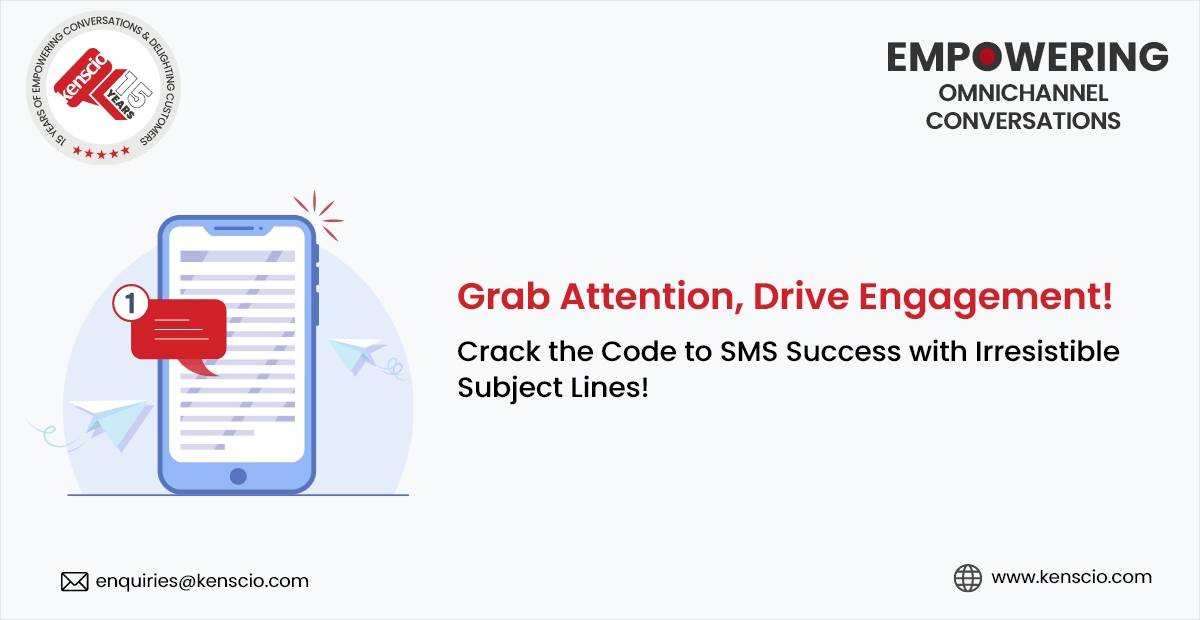- June 12, 2024
- by Hardik Vyas
Unveiling the Art of Crafting Attention-Grabbing SMS Subject Lines
As it has always been before, your familiar age-old friend, the humble Short Message Service (SMS), is still one of the most essential mediums for reaching out to customers and continues to hold its ground as a direct and immediate means of communication.
SMS messages present a golden opportunity for businesses to connect with their customers personally and effectively.
The Importance of SMS Marketing
SMS marketing offers unparalleled benefits, making it indispensable for businesses of all sizes. Its immediacy ensures that messages are delivered promptly and read quickly. It boasts of an astonishing open rate of around 98%, which far surpasses email marketing. Moreover, it also has an impressive response rate, with studies suggesting that 90% of messages are read within three minutes of being received. This promptness makes SMS an ideal channel for time-sensitive promotions, flash sales, and urgent alerts.
Furthermore, SMS marketing enables businesses to engage with customers more personally. By sending targeted messages based on customers’ preferences, behaviors, and demographics, businesses can foster a sense of intimacy and relevance, thereby enhancing brand loyalty and customer satisfaction.
The Role of Subject Lines in SMS Marketing
While the content of an SMS message is crucial, the subject line plays a pivotal role in grabbing the recipient’s attention and enticing them to open the message. In a world inundated with notifications and alerts, a compelling subject line can make all the difference between a message being read or ignored.
Crafting Attention-Grabbing SMS Subject Lines
Keep it Concise:
With SMS, brevity is key. Aim to convey your message succinctly within the limited character count (typically 160 characters). Ensure to get straight to the point. Use language that is clear, concise, and easy to understand at a glance.
Example: “Flash Sale: 50% Off Everything! Today Only!”
Personalization:
Instill a sense of urgency in your subject line to prompt immediate action. Phrases like “Limited Time Offer” or “Last Chance” create a sense of FOMO (Fear of Missing Out) and compel recipients to act quickly before the opportunity expires.
Example: “Hurry! Sale Ends Tonight at Midnight!”
Offer Value:
Clearly communicate your message’s benefit or value proposition in the subject line. Whether it’s a discount, exclusive offer, or valuable information, make it clear why recipients should open the message and what’s in it for them.
Example: “Unlock Your Free Gift Inside!”
Use Emojis Sparingly:
Emojis can add visual appeal and convey emotions effectively, but use them judiciously. Overuse of emojis can make your message appear unprofessional or spammy. Use emojis strategically to complement your message and enhance its appeal.
Example: “New Arrival Alert! 🚀 Shop Now for the Best Selection!”
A/B Testing:
Make sure to experiment with different subject lines to determine which ones resonate best with your audience. A/B testing allows you to refine your messaging strategy and optimize open rates over time. Test language, tone, and formatting variations to identify what works best for your audience.
Avoid Spam Triggers:
Steer clear of spammy language and symbols that might trigger spam filters or deter recipients from opening your message. Words like “free,” “urgent,” or excessive use of exclamation marks should be used sparingly to maintain credibility and professionalism.
Example: “Act Now for Your Chance to Win! 🎁”
Maintain Consistency
Ensure that your subject line aligns with the content of your message to avoid confusion or disappointment. Misleading subject lines can erode trust and damage your brand reputation. Be transparent and honest in your messaging to build credibility with your audience.
Example: “Your Order Confirmation: Track Your Package Now!”
Include a Call-to-Action:
Encourage recipients to take action by including a clear call-to-action (CTA) in your subject line. Whether it’s “Shop Now,” “Learn More,” or “Claim Your Discount,” prompt recipients to engage with your message and take the desired action.
Example: “Limited Time Offer: Claim Your 20% Discount Today!”
Test, Analyze, Iterate
Continuously monitor the performance of your SMS campaigns and subject lines. Analyze metrics such as open rates, click-through rates, and conversions to identify areas for improvement and refine your approach accordingly. Iterate your messaging strategy based on data-driven insights to maximize the effectiveness of your SMS marketing efforts.
Example: Analyze Subject Line Performance:
Which Subject Lines Generate the Highest Open Rates? Adjust Messaging Strategy Accordingly.
